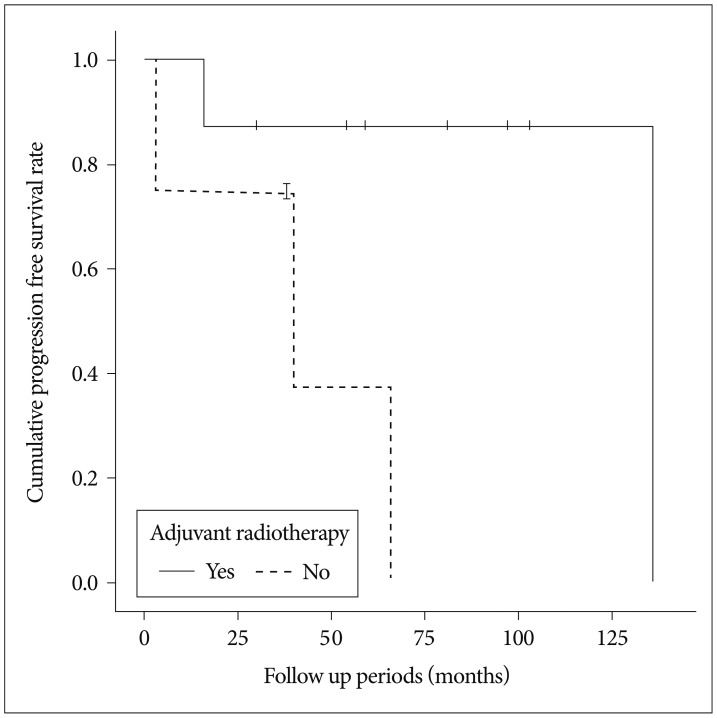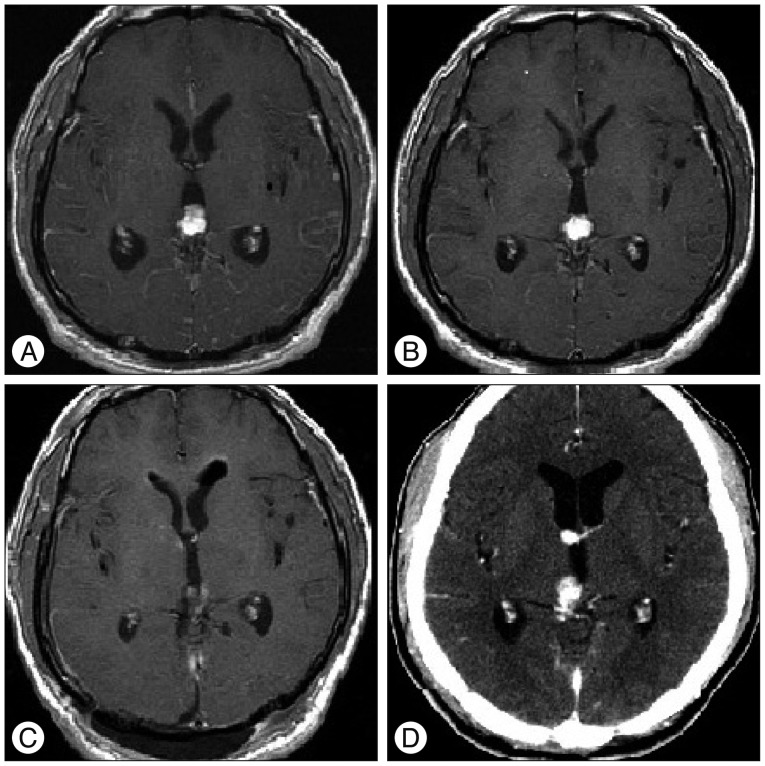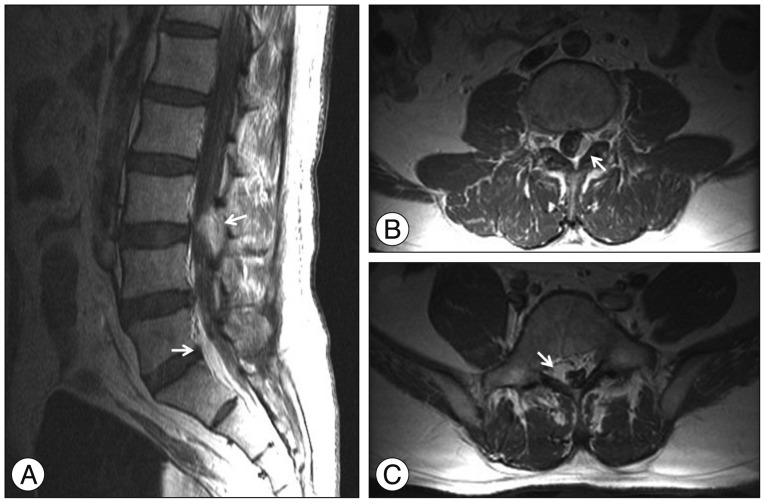J Korean Neurosurg Soc.
2014 Sep;56(3):194-199. 10.3340/jkns.2014.56.3.194.
Clinical Features and Treatment Outcome of Chordoid Meningiomas in a Single Institute
- Affiliations
-
- 1Department of Neurosurgery, Samsung Medical Center, Sungkyunkwan University School of Medicine, Seoul, Korea. shinhj@skku.edu
- KMID: 2339956
- DOI: http://doi.org/10.3340/jkns.2014.56.3.194
Abstract
OBJECTIVE
Meningioma is the second most common primary central nervous system neoplasm. In contrast, chordoid meningioma is rare; due to the paucity of cases, little is known about its clinical features or treatment outcomes. The objectives of this study were to describe the clinical characteristics and outcomes for patients with chordoid meningioma.
METHODS
In total, 16 patients, with newly diagnosed chordoid meningioma who underwent surgical excision between 1999 and 2012 were included. We retrospectively evaluated the medical records, radiological findings, and pathological findings. The median follow-up period was 56.5 (range, 3-170) months. The MIB-1 labeling index ranged from 1 to 26.60% (median, 5.04).
RESULTS
Simpson grade I, II, and III resections were performed in four, nine, and three patients, respectively. The overall recurrence rate was 37.5%. Overall progression-free survival (PFS) after resection was 94.7 months (95% CI=62.9-126.6). Of the 4 patients with Simpson grade I resection, recurrence occurred in one patient. Among the Simpson grade II and III resection groups, eight patients underwent adjuvant radiation therapy and they showed significantly longer PFS (121 months, 95% CI=82.1-159.9) than the patients who underwent surgery alone (40.5 months, 95% CI=9.6-71.3) by the log-rank test (p<0.05).
CONCLUSION
Chordoid meningiomas are difficult to manage and have a high rate of recurrence. Complete resection of the tumor is a key determinant of better outcomes. Adjuvant radiation therapy is recommended, eparticulary when Simpson grade I resection was not achieved.
MeSH Terms
Figure
Reference
-
1. Amatya VJ, Takeshima Y, Sugiyama K, Kurisu K, Nishisaka T, Fukuhara T, et al. Immunohistochemical study of Ki-67 (MIB-1), p53 protein, p21WAF1, and p27KIP1 expression in benign, atypical, and anaplastic meningiomas. Hum Pathol. 2001; 32:970–975. PMID: 11567227.
Article2. Barbaro NM, Gutin PH, Wilson CB, Sheline GE, Boldrey EB, Wara WM. Radiation therapy in the treatment of partially resected meningiomas. Neurosurgery. 1987; 20:525–528. PMID: 3587542.
Article3. Choi KC, Joo WI, Jang KS, Kim MC. Chordoid meningioma. J Korean Neurosurg Soc. 2005; 38:390–392.4. Goldsmith BJ, Wara WM, Wilson CB, Larson DA. Postoperative irradiation for subtotally resected meningiomas. A retrospective analysis of 140 patients treated from 1967 to 1990. J Neurosurg. 1994; 80:195–201. PMID: 8283256.5. Ho DM, Hsu CY, Ting LT, Chiang H. Histopathology and MIB-1 labeling index predicted recurrence of meningiomas : a proposal of diagnostic criteria for patients with atypical meningioma. Cancer. 2002; 94:1538–1547. PMID: 11920512.
Article6. Hug EB, Devries A, Thornton AF, Munzenride JE, Pardo FS, Hedley-Whyte ET, et al. Management of atypical and malignant meningiomas : role of high-dose, 3D-conformal radiation therapy. J Neurooncol. 2000; 48:151–160. PMID: 11083080.7. Jääskeläinen J, Haltia M, Servo A. Atypical and anaplastic meningiomas : radiology, surgery, radiotherapy, and outcome. Surg Neurol. 1986; 25:233–242. PMID: 3945904.
Article8. Jeon CJ, Kim MJ, Lee JS, Lee JH, Kong DS, Shin HJ, et al. Castleman's disease associated with a cerebellar chordoid meningioma and intestinal lymphangiectasia. Childs Nerv Syst. 2010; 26:1647–1652. PMID: 20567835.
Article9. Jo KW, Kim CH, Kong DS, Seol HJ, Nam DH, Park K, et al. Treatment modalities and outcomes for asymptomatic meningiomas. Acta Neurochir (Wien). 2011; 153:62–67. discussion 67. PMID: 20953804.
Article10. Kasuya H, Kubo O, Tanaka M, Amano K, Kato K, Hori T. Clinical and radiological features related to the growth potential of meningioma. Neurosurg Rev. 2006; 29:293–296. discussion 296-297. PMID: 16953450.
Article11. Konstantinidou AE, Korkolopoulou P, Kavantzas N, Mahera H, Thymara I, Kotsiakis X, et al. Mitosin, a novel marker of cell proliferation and early recurrence in intracranial meningiomas. Histol Histopathol. 2003; 18:67–74. PMID: 12507285.12. Kozler P, Benes V, Netuka D, Kramár F, Hrabal P, Charvát F. Chordoid meningioma : presentation of two case reports, review of the literature, and plea for data standardisation. J Neurooncol. 2008; 88:115–120. PMID: 18320142.
Article13. Lin JW, Lu CH, Lin WC, Wu YT, Huang YJ, Shih FY, et al. A clinicopathological study of the significance of the proportion of choroid morphology in chordoid meningioma. J Clin Neurosci. 2012; 19:836–843. PMID: 22516546.
Article14. Lüdemann WO, Obler R, Tatagiba M, Samii M. Seeding of malignant meningioma along a surgical trajectory on the scalp. Case report and review of the literature. J Neurosurg. 2002; 97:683–686. PMID: 12296654.
Article15. Matsuno A, Fujimaki T, Sasaki T, Nagashima T, Ide T, Asai A, et al. Clinical and histopathological analysis of proliferative potentials of recurrent and non-recurrent meningiomas. Acta Neuropathol. 1996; 91:504–510. PMID: 8740231.
Article16. Matsuno A, Nagashima T, Matsuura R, Tanaka H, Hirakawa M, Murakami M, et al. Correlation between MIB-1 staining index and the immunoreactivity of p53 protein in recurrent and non-recurrent meningiomas. Am J Clin Pathol. 1996; 106:776–781. PMID: 8980354.
Article17. Nakaguchi H, Fujimaki T, Matsuno A, Matsuura R, Asai A, Suzuki I, et al. Postoperative residual tumor growth of meningioma can be predicted by MIB-1 immunohistochemistry. Cancer. 1999; 85:2249–2254. PMID: 10326705.
Article18. Nakasu S, Li DH, Okabe H, Nakajima M, Matsuda M. Significance of MIB-1 staining indices in meningiomas : comparison of two counting methods. Am J Surg Pathol. 2001; 25:472–478. PMID: 11257621.19. Perry A, Stafford SL, Scheithauer BW, Suman VJ, Lohse CM. The prognostic significance of MIB-1, p53, and DNA flow cytometry in completely resected primary meningiomas. Cancer. 1998; 82:2262–2269. PMID: 9610708.
Article20. Sadahira Y, Sugihara K, Manabe T. Iatrogenic implantation of malignant meningioma to the abdominal wall. Virchows Arch. 2001; 438:316–318. PMID: 11315631.
Article21. Sandberg DI, Edgar MA, Resch L, Rutka JT, Becker LE, Souweidane MM. MIB-1 staining index of pediatric meningiomas. Neurosurgery. 2001; 48:590–595. discussion 595-597. PMID: 11270550.
Article22. Simpson D. The recurrence of intracranial meningiomas after surgical treatment. J Neurol Neurosurg Psychiatry. 1957; 20:22–39. PMID: 13406590.
Article23. Strik HM, Strobelt I, Pietsch-Breitfeld B, Iglesias-Rozas JR, Will B, Meyermann R. The impact of progesterone receptor expression on relapse in the long-term clinical course of 93 benign meningiomas. In Vivo. 2002; 16:265–270. PMID: 12224136.24. Tena-Suck ML, Collado-Ortìz MA, Salinas-Lara C, García-López R, Gelista N, Rembao-Bojorquez D. Chordoid meningioma : a report of ten cases. J Neurooncol. 2010; 99:41–48. PMID: 20094774.25. Wang XQ, Mei GH, Zhao L, Li ST, Gong Y, Zhong J, et al. Clinical features and treatment of intracranial chordoid meningioma : a report of 30 cases. Histopathology. 2013; 62:1002–1017. PMID: 23617629.
Article
- Full Text Links
- Actions
-
Cited
- CITED
-
- Close
- Share
- Similar articles
-
- Chordoid Glioma of the Third Ventricle with Unusual MRI Features
- Chordoid Glioma: an Uncommon Tumor of the Third Ventricle
- A Case of Thoracic Extradural Chordoid Meningioma: Focusing on Radiologic Features
- Chordoid Glioma with Intraventricular Dissemination: A Case Report with Perfusion MR Imaging Features
- Suprasellar Chordoid Glioma Combined with Rathke's Cleft Cyst: Case Report





